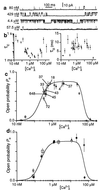Inositol 1,4,5-trisphosphate [correction of tris-phosphate] activation of inositol trisphosphate [correction of tris-phosphate] receptor Ca2+ channel by ligand tuning of Ca2+ inhibition
- PMID: 9861054
- PMCID: PMC28128
- DOI: 10.1073/pnas.95.26.15821
Inositol 1,4,5-trisphosphate [correction of tris-phosphate] activation of inositol trisphosphate [correction of tris-phosphate] receptor Ca2+ channel by ligand tuning of Ca2+ inhibition
Erratum in
- Proc Natl Acad Sci U S A 1999 Mar 16;96(6):3330
Abstract
Inositol 1,4,5-trisphosphate (IP3) [corrected] binding to its receptors (IP3R) in the endoplasmic reticulum (ER) activates Ca2+ release from the ER lumen to the cytoplasm, generating complex cytoplasmic Ca2+ concentration signals including temporal oscillations and propagating waves. IP3-mediated Ca2+ release is also controlled by cytoplasmic Ca2+ concentration with both positive and negative feedback. Single-channel properties of the IP3R in its native ER membrane were investigated by patch clamp electrophysiology of isolated Xenopus oocyte nuclei to determine the dependencies of IP3R on cytoplasmic Ca2+ and IP3 concentrations under rigorously defined conditions. Instead of the expected narrow bell-shaped cytoplasmic free Ca2+ concentration ([Ca2+]i) response centered at approximately 300 nM-1 microM, the open probability remained elevated (approximately 0.8) in the presence of saturating levels (10 microM) of IP3, even as [Ca2+]i was raised to high concentrations, displaying two distinct types of functional Ca2+ binding sites: activating sites with half-maximal activating [Ca2+]i (Kact) of 210 nM and Hill coefficient (Hact) approximately 2; and inhibitory sites with half-maximal inhibitory [Ca2+]i (Kinh) of 54 microM and Hill coefficient (Hinh) approximately 4. Lowering IP3 concentration was without effect on Ca2+ activation parameters or Hinh, but decreased Kinh with a functional half-maximal activating IP3 concentration (KIP3) of 50 nM and Hill coefficient (HIP3) of 4 for IP3. These results demonstrate that Ca2+ is a true receptor agonist, whereas the sole function of IP3 is to relieve Ca2+ inhibition of IP3R. Allosteric tuning of Ca2+ inhibition by IP3 enables the individual IP3R Ca2+ channel to respond in a graded fashion, which has implications for localized and global cytoplasmic Ca2+ concentration signaling and quantal Ca2+ release.
Figures




References
-
- Berridge M J. Nature (London) 1993;361:315–325. - PubMed
-
- Meyer T, Stryer L. Annu Rev Biophys Biophys Chem. 1991;20:153–174. - PubMed
-
- Toescu E C. Am J Physiol. 1995;269:G173–G185. - PubMed
-
- Bootman M D. Mol Cell Endocrinol. 1994;98:157–166. - PubMed
-
- Parys J B, Missiaen L, De Smedt H, Sienaert I, Casteels R. Pflügers Arch. 1996;432:359–367. - PubMed
Publication types
MeSH terms
Substances
LinkOut - more resources
Full Text Sources
Miscellaneous

